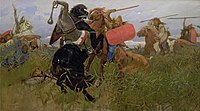Contents
 |
| Knyaz (sovereign) |
| Boyar / Szlachta (noble) |
| Druzhinnik (retainer) |
| Smerd (free tenant) |
| Kholop (slave) |
A kholop (Russian: холо́п, IPA: [xɐˈlop]) was a type of feudal serf (dependent population) in Kievan Rus' in the 9th and early 12th centuries.[1] Their legal status in Russia was essentially the same as slaves.[2](p 576) They were sold as any other property of their master until the emancipation reform of 1861.[citation needed] The term kholop was excluded from official use in 1724, but it remains in vernacular use as a type of insult.[citation needed]
Etymology
The word Russian: холо́п (kholop) was first mentioned in a chronicle for the [[year 986 CE.]] The word is cognate with Slavic words translated as "man" or "boy" (Ukrainian: хлопець (khlopets), Polish: chłopiec, Bulgarian: хлапе / хлапак (ᵏhlape / ᵏhlapak) "kid"). Chlap / chlop (pronounced "ᵏhlap" / "ᵏhlop") is a synonym for "man" in Slovak (chlapec thus being the diminutive).[3] Such transitions between the meanings "young person" and "servant" (in both directions) are commonplace, as evident from the English use of "boy" in the sense of "domestic servant".
| Part of a series on |
| Slavery |
|---|
 |
Kholops

The Russkaya Pravda, a legal code of the late Kievan Rus', details the status and types of kholops of the time.
In the 11th–12th centuries, the term referred to different categories of dependent people and especially slaves. A kholop's master had unlimited power over his life, e.g., he could kill him, sell him, or transfer ownership of him to settle a debt. The master, however, was responsible for a kholop's actions, such as insulting a freeman or stealing.
A person could become a kholop as a result of capture, selling oneself, being sold for debts, after having committed crimes, or through marriage to a kholop. Until the late 15th century, the kholops represented a majority among the servants, who had been working lordly lands. Some kholops, mainly house serfs, replenished the ranks of the princely servants (including those in the military) or engaged themselves in trades, farming, or administrative activities.
Throughout the 16th century, the role of the kholops in the corvée economy had been diminishing due to the increasing involvement of peasant exploitation (see Russian serfdom). At the turn of the 16th century, the service class kholops (служилое холопство, sluzhiloye kholopstvo) began to emerge and spread across the country. In the late 17th century, there were also kholops "implanted" to their land (посаженные на землю, posazhenniye na zemlyu), who took care of their own household and had to pay chynsh (similar to quitrent). Those kholops, who had been house serfs were subject to poll tax (per-soul tax, podushnaya podat) in 1722–1724, and were thereafter treated as ordinary serfs (krepostnyye, "permanent peasants").[4]
Combat kholops

Boevie kholopi (Russian: боевые холопы, "combat slaves"), also known as "military slaves" in literature,[2](p383) constituted an armed retinue and personal protection for large and medium-sized landowners in the 16th–18th centuries, and carried out military service together with noblemen, constituting a considerable part of the "Landed Army". They were equipped as mounted archers, usually wearing cheap quilted armor and caps.[5]
Kabala kholops (debt slaves)
"Kabala people" was a variation of kholops in Muscovy of 15th–17th centuries. This category of unfree population came under the "kabala" (heavy debt bondage) condition following a monetary loan for percentage of which it had serve its creditor until completion of the debt payment.[4] Legal status of the Kabala kholops was regulated by general kholops norms and laws Sudebnik of 1550, Sobornoye Ulozheniye of 1649. After the Ukaze of 1 February 1597, the principle of the kholop's servitude until the death of his / her creditor was enacted.[4] Over time, all types of kholops were placed to the category of Kabala kholops. Agreements on Kabala kholops were inscribed in "Kabala books".[4]
References
- ^ Shemshuchenko, Yuri. "ХОЛОПИ" [holopi ("serf")]. Юридична енциклопедія (Legal Encyclopedia) (leksika.com.ua) (in Ukrainian).
- ^ a b Perrie, Maureen; Lieven, D.C.B.; Suny, Ronald Grigor (2006). The Cambridge History of Russia. Cambridge, UK: Cambridge University Press. ISBN 9780521812276. OCLC 77011698.
- ^ Vasmer, Max (1959–1961). "холоп". Etymological Dictionary of the Russian Language. Translated by Trubachyov, O.N.
- ^ a b c d "КАБАЛЬНІ ХОЛОПИ" [debt slaves ("kabalni holopi")]. Ukrainian Soviet Encyclopedia (in Ukrainian) – via leksika.com.ua.
- ^ Viskovatov, Alexander Vasilyevich (1841–1862). Историческое описание одежды и вооружения российских войск [Historical Description of Clothing and Weapons of Russian Troops] (in Russian) (Второе изд. – 2nd ed.). St. Petersburg, RU: Chief Quartermaster Exerc. Retrieved 2018-03-21 – via runivers.ru. — Detailed descriptions of the military and civil clothing in Russia from 862–1855 CE.
Sources
- This article includes content derived from the Great Soviet Encyclopedia, 1969–1978, which is partially in the public domain.

